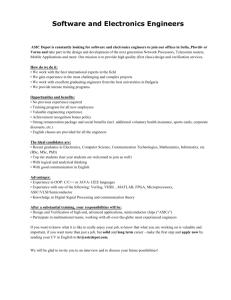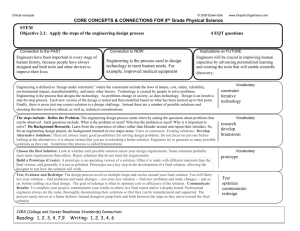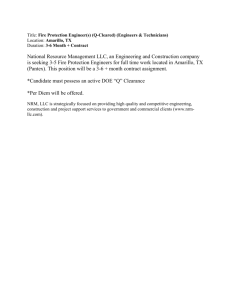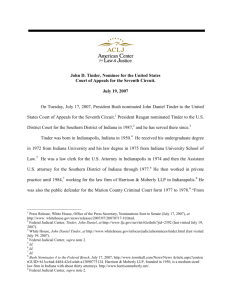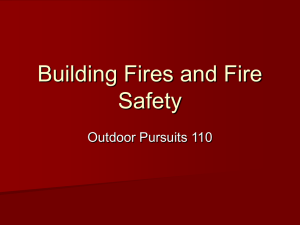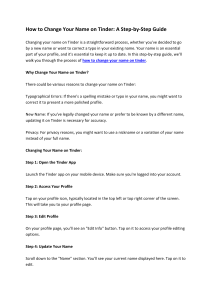6-8
advertisement
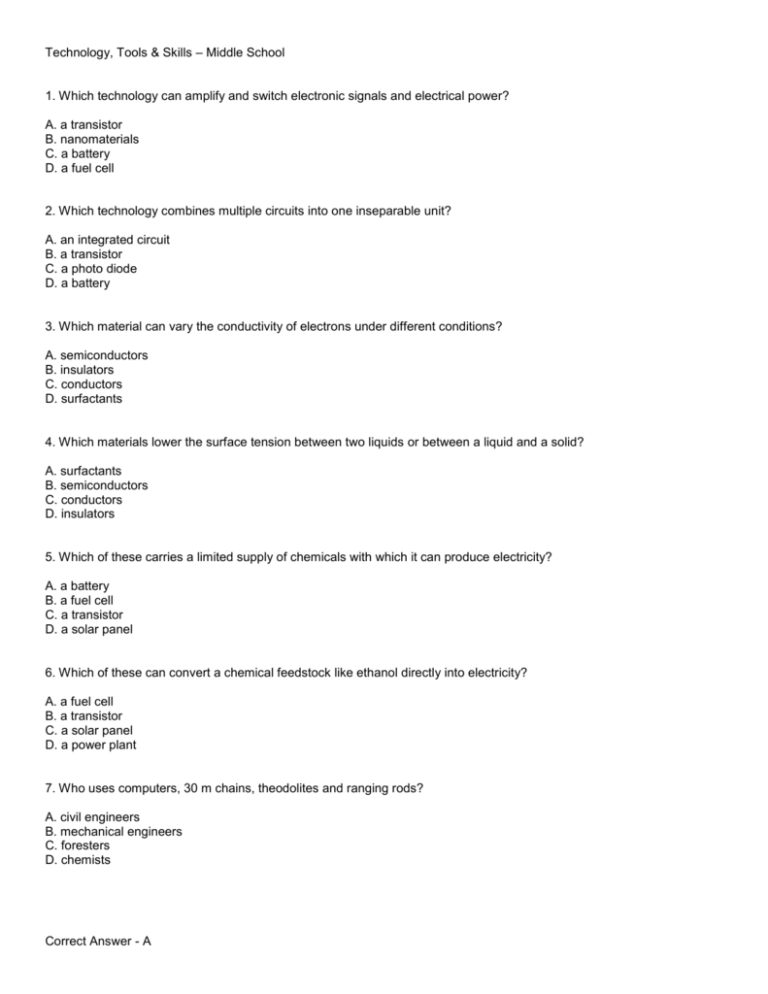
Technology, Tools & Skills – Middle School 1. Which technology can amplify and switch electronic signals and electrical power? A. a transistor B. nanomaterials C. a battery D. a fuel cell 2. Which technology combines multiple circuits into one inseparable unit? A. an integrated circuit B. a transistor C. a photo diode D. a battery 3. Which material can vary the conductivity of electrons under different conditions? A. semiconductors B. insulators C. conductors D. surfactants 4. Which materials lower the surface tension between two liquids or between a liquid and a solid? A. surfactants B. semiconductors C. conductors D. insulators 5. Which of these carries a limited supply of chemicals with which it can produce electricity? A. a battery B. a fuel cell C. a transistor D. a solar panel 6. Which of these can convert a chemical feedstock like ethanol directly into electricity? A. a fuel cell B. a transistor C. a solar panel D. a power plant 7. Who uses computers, 30 m chains, theodolites and ranging rods? A. civil engineers B. mechanical engineers C. foresters D. chemists Correct Answer - A Technology, Tools & Skills – Middle School 8. Who uses computers, strain gauges and accelerometers? A. mechanical engineers B. civil engineers C. foresters D. chemists 9. Who uses computers, compasses, axes and Biltmore Sticks? A. foresters B. civil engineers C. chemists D. mechanical engineers 10. Who uses computers, flasks, beakers and balances? A. chemists B. civil engineers C. foresters D. mechanical engineers 11. Where can you find information on when to plant vegetables in your area? A. a sowing guide B. local building codes C. a wildflower guide D. a calendar 12. Everything else being equal, where is the best side to put a vegetable garden relative to shade producing structures like fences, walls, buildings and tall trees? A. the south side B. the north side C. the east side D. the west side 13. On which side of a vegetable garden should the taller plants go? A. the north side B. the south side C. the east side D. the west side 14. Which materials have a high carbon to nitrogen ratio? A. leaves, newspaper, wood chips B. grass clippings, manure, pet waste C. alfalfa, clover, sea weed D. manure, coffee grounds, meat scraps Correct Answer - A Technology, Tools & Skills – Middle School 15. Where can you find out how many outlets a room should have, insulation requirements for walls, and the distance between joists in new houses? A. local building codes B. a sowing guide C. a home and garden magazine D. a carpentry magazine 16. Which materials have a low carbon to nitrogen ratio A. grass clippings, manure, alfalfa B. leaves, wood chips, sawdust C. newspaper, cardboard D. straw, pine needles, ashes 17. For an effective compost pile, you need 30 parts carbon to 1 part nitrogen. If a pile has 15 parts carbon to 1 part nitrogen, what do you need to add to make it work well? A. more carbon B. more nitogen C. more carbon and nitrogen D. nothing 18. If you are riding a bicycle uphill and it is getting difficult to pedal, what can you do to make it easier? A. shift into a lower gear B. shift into a higher gear C. shift into the highest gear D. stay in the current gear 19. A bicycle is a compound machine. What are some of the simple machines that are part of a bicycle? A. a wheel and axle B. a wedge C. an inclined plane D. a button 20. What is a device that changes the direction or amplitude of a single applied force on a single load force? A. a simple machine B. a compound machine C. a motor D. a fuel cell 21. What is an apparatus that connects several devices that can change the direction or amplitude of an applied force on a load force? A. a compound machine B. a simple machine C. a photo diode D. a fuel cell Correct Answer - A Technology, Tools & Skills – Middle School 22. If you get lost in the woods, and you know people will be looking for you, the best thing is to stay where you are. Why? A. people will start looking for you near the place you became lost B. compasses don't work once you get off the trail C. it is the safest place for you to be in D. wild animals are more likely to leave you alone if you stay in one place 23. What should you NOT do if you get lost in the woods? A. drink water from a stream B. stay where you are C. call out every few minutes D. look around for materials to make a temporary shelter 24. Which of these plants can cause a persistent itchy red rash? A. poison ivy, poison oak or poison sumac B. stinging nettles or smilax C. buckthorns or hawthorns D. sawgrass or whipgrass 25. What should you do if you encounter a snake in the outdoors? A. make a big circle around it B. kill it C. walk quickly back the way you came D. climb a tree 26. How should a campfire be put out? A. scatter embers, smother them with water or soil, then stomp on them B. scatter embers and make sure there is no flammable wood nearby C. pour a bucket of water on the fire D. wait until it burns down and poke it to make sure there are no sparks 27. Which of these makes good tinder? A. cedar bark, pine needles or dried weed tops B. cottonwood, alder or willow sticks C. oak, maple or hickory branches D. acorns, leaves or new grass 28. In what order are the listed materials lit to make and sustain a campfire? A. tinder, kindling, fuelwood B. fuelwood, kindling, tinder C. kindling, fuelwood, tinder D. fuelwood, tinder, kindling Correct Answer - A Technology, Tools & Skills – Middle School 29. Where is it safe to drink surface or spring water in the U.S.? A. nowhere B. only in the woods C. only in prairies D. only on mountains 30. What is the difference between true north and magnetic north on a compass called? A. declination B. direction C. latitude D. interference Correct Answer - A



